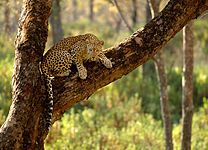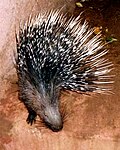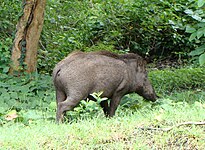Kalesar National Park
| Kalesar National Park | |
|---|---|
 | |
| Type | National park |
| Location | Kalesar, Yamunanagar district, Haryana |
| Coordinates | 30°22′N 77°32′E / 30.367°N 77.533°E |
| Status | Open |
| Website | www |
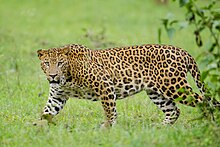
Kalesar National Park (13,000 acres (53 km2)) and adjacent Kalesar Wildlife Sanctuary (13,209 acres (53.45 km2) are protected areas in Kalesar of
History
Kalesar National Park spread across 13,000 acres (53 km2) was notified on 8 December 2003 and adjacent 13,209 acres (53.45 km2) Kalesar Wildlife Sanctuary was notified on 13 December 1996.[5][6] However, it is alleged, absence of sufficient funds from the centre is proving to be a hindrance in wildlife conservation in the national park.
Etymology
Kalesar National Park is named after the Kalesar Mahadev temple located in this national park.[2]
18th and 19th century
Afghan invader
Kalesar Mahadev temple
The ancient Kalesar Mahadev temple takes its name from the a corrupted form of Kaleshwar, a moniker of
As part of INR1200 crore Morni to Kalesar tourism development plan announced in January 2019, Government of Haryana is developing this temple, along with Kapal Mochan Tirth, Panchmukhi Hanuman temple of Basatiyawala, Sharda Mata Temple of Chotta Trilokpur and Lohgarh fort capital of Banda Singh Bahadur.[8]
Colonial Dak Bungalow
This area, excellent for the bird watchers and
Geography
The Kalesar national park and wildlife sanctuary are located on both sides of
Wildlife Safaris
Jeep safaris are available on the following 3 motorable tracks only during the designated park opening months and hours: 20 feet wide route-1 of 7 km, 60 feet wide route-2 of 6.5 km and 60 feet wide route-3 of 6 km.[5] Private vehicles are not allowed on these routes, except only those pre-registered with the wildlife department for the purpose of operating safaris.[5] Park is closed July to September and during the remaining months visiting hours are 6 am to 10 am and 4 pm to 7 pm during summers, and 7 am to 11 am and 3.30 pm to 6 pm during winters.[5]
Shivalik foothills
The foothills of
Flora
Dense old forest
Kalesar has 53% dense forest, 38% open forest, 9% scrub. Total forest cover is about 71%. Spread over an area of 11,570 acres (46.8 km2), Kalesar reserve forest is the only one of its kind in Haryana. Besides the tall, leafy
Medicinal plants
In the
Fauna
Wild animals
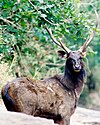
In 2016, survey recorded
Earlier May 2004 survey in collaboration with
etc.Leopard

In 2016, the annual two-month animal counting survey done by the
Elephants
Kalesar Wildlife Sanctuary has natural population of the wild elephants. It is also home to the Ch. Surinder Singh Elephant Rehabilitation Centre (ERC) at Ban Santoor, which is a sanctuary to rehabilitate the rescued abused, exploited and sick elephants.[11][12] It was set up by the Haryana Forests department in association with an NGO called Wildlife SOS, with the help of Government of India grant under the Project Elephant. ERC has elephant shelters, veterinary services, elephant husbandry and fodder service, elephant walking and exercise trails, etc.[12] In 2015, it had 3 rescued female elephants, namely Erica, Ella and Lilly.[11] Wild elephants also roam Kalesar and adjoining Rajaji National Park and Tiger Reserve spread across Uttrakhand and Himachal Pradesh. In January 2018, Delhi Forests department planned to rescue all the 7 domesticated elephants of Delhi kept in captivity, 2 of which will be sent to Kalesar Wildlife Sanctuary in Haryana and 4 will be sent to Rajaji National Park and Tiger Reserve in Uttrakhand.[13]
Wildlife preservation
Eight watering holes have been dug up across the forest area to ensure that the wildlife does not stray into human habitats on its fringes in search of drinking water. Earthen dams have also been constructed to conserve rainwater for use of wildlife. Apart from this, there is proposal of Construction of 8 dams within this sanctuary area which is at the stage of Forest and wildlife clearances which is being taken care by Er. Navneet Kumar from Gaya Bihar working in Haryana Irrigation Department.
There is a plan to build a fence around the area.
Wildlife protection force and courts
As for the steps taken to ensure protection of wildlife and environment, the forest staff have been given weapons by the state government to tackle the menace posed by poachers. The state had also set up two special environmental courts in Kurukshetra and Faridabad to deal with crimes related to poaching and illicit felling of trees from the area.
Monitoring and census cameras
The Forests Department, Haryana, with funding provided by the Wildlife Institute of India, installed 80 cameras at 40 locations across the park in December 2014, primarily to monitor the movements of tigers, leopards and other animals in the park, as well as to conduct annual two-month long animal species and animal count survey.[3][6]
Gallery
-
Indian leopard is found here
-
Elephant
-
Indian hare is found at Kalesar
-
Indian grey mongoose is found at Kalesar
-
Indian crested porcupine is found at Kalesar
-
Wild boar
-
Langur monkey
-
Indian robin
References
See also
- Ch. Devi Lal Herbal Nature Park
- List of National Parks & Wildlife Sanctuaries of Haryana, India
- List of national parks of India
- Wildlife sanctuaries of India
Citations
- ^ "Kalesar National Park". Haryana Forest Department. Retrieved 8 August 2014.
- ^ a b c d e f g BriefReportonBio-diversity, Forests Clearance, 1989.
- ^ a b c d 2 Leopard spotted in Kalesar National park, Published 16 June 2016
- ^ Kalesar forest under miners' attack
- ^ a b c d e f g h i Kalesar National Park Archived 8 March 2018 at the Wayback Machine, Haryana Forests.
- ^ The Tribune. Retrieved 10 January 2015.
- ^ District Gazetteer of Ambala, 1892-93.
- ^ Kalesar-Kalka stretch to be promoted for tourism, The Tribune, 18 January 2019.
- ^ Government of India's Ministry of Environment and Forests clearance, published: 2013
- ^ a b 42 leopards spotted in Kalesar National Park, Haryana, India Today, 2016.
- ^ a b Ch. Surinder Singh Elephant Rehabilitation Centre (ERC), Wildlife SOS, 2015.
- ^ a b Elephant rescue facilities, Wild SOS.
- ^ In Delhi’s ‘jumbo loss’, major gain for Uttarakhand tiger reserve, Hindustan Times, 31 January 2018.



